Author:
Janice Evans
Date Of Creation:
23 July 2021
Update Date:
1 July 2024

Content
- Steps
- Part 1 of 3: Safely Release the Mouse
- Part 2 of 3: Returning the Mouse to the Wild
- Part 3 of 3: How to keep mice away from home
- Warnings
A gummy mousetrap is a type of trap used to trap mice, rats, and other rodents. It consists of a flat base covered with very sticky glue and is dangerous for children, pets, wild animals and other creatures. If not rescued, small animals trapped in the gummy mousetrap will die a long and painful death as a result of exhaustion, hunger, dehydration, injury and external influences. Fortunately, if you find a mouse or other animal trapped, there is a fairly simple way to free it: you will need to use vegetable oil to loosen the glue.
Steps
Part 1 of 3: Safely Release the Mouse
 1 Put on gloves. Rodents are carriers of many dangerous diseases that they can transmit to humans. To protect yourself from bites, scratches, and infection, be sure to wear a pair of heavy-duty gloves.
1 Put on gloves. Rodents are carriers of many dangerous diseases that they can transmit to humans. To protect yourself from bites, scratches, and infection, be sure to wear a pair of heavy-duty gloves. - Work gloves, gardening gloves for working with roses, and sturdy leather gloves are suitable for this purpose.
 2 Place the mouse in the container. Lift the mouse trap and carefully move it to a clear plastic container or box. The container must be larger than the sticky trap and must be at least 10 cm deep.
2 Place the mouse in the container. Lift the mouse trap and carefully move it to a clear plastic container or box. The container must be larger than the sticky trap and must be at least 10 cm deep.  3 Cover the mouse with a towel. Take an old rag or towel, which you will not mind throwing away later. Place a towel gently over the mouse's head to calm it down. Place your hand on the back of the mouse and hold it while you release it.
3 Cover the mouse with a towel. Take an old rag or towel, which you will not mind throwing away later. Place a towel gently over the mouse's head to calm it down. Place your hand on the back of the mouse and hold it while you release it. 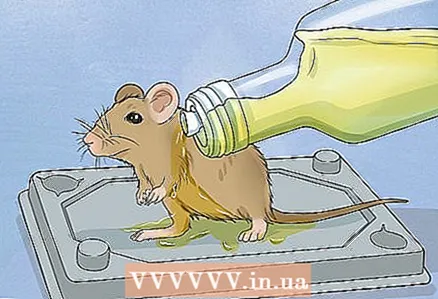 4 Pour vegetable oil over the trap. Oil the area where the mouse is stuck. Use as little oil as possible and, if possible, try not to pour oil directly onto the mouse. Use a cotton swab or rag to rub the oil into the glue.
4 Pour vegetable oil over the trap. Oil the area where the mouse is stuck. Use as little oil as possible and, if possible, try not to pour oil directly onto the mouse. Use a cotton swab or rag to rub the oil into the glue. - While liquid vegetable oil is ideal for the job, if you don't have one on hand, you can use cooking spray or baby oil.
 5 Free the mouse. Continue rubbing the area around the mouse for a few minutes. After some time, the glue will begin to lose its properties, and the mouse will be able to escape from the trap. Once the mouse is free, remove the trap from the container.
5 Free the mouse. Continue rubbing the area around the mouse for a few minutes. After some time, the glue will begin to lose its properties, and the mouse will be able to escape from the trap. Once the mouse is free, remove the trap from the container. - Place the trap in a plastic bag and close it before throwing it in the trash can.
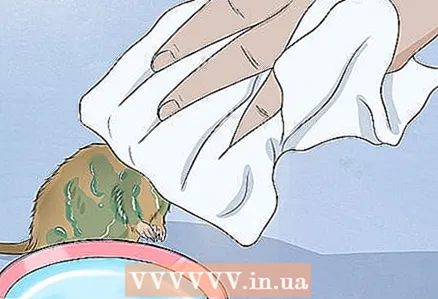 6 Wipe off excess oil. Soak an old rag in warm water and then wring it out. Use a rag to wipe off any remaining oil from the paws, head, and body of the mouse.
6 Wipe off excess oil. Soak an old rag in warm water and then wring it out. Use a rag to wipe off any remaining oil from the paws, head, and body of the mouse. - Since oil has a negative effect on the function of regulating the body temperature of the mouse, wipe it off as best you can.
 7 Let the mouse rest. Place a small bowl of fresh water in the mouse container. Cover the container with a towel to create a dark, warm and calm atmosphere inside. Give your mouse at least an hour to sit back and relax.
7 Let the mouse rest. Place a small bowl of fresh water in the mouse container. Cover the container with a towel to create a dark, warm and calm atmosphere inside. Give your mouse at least an hour to sit back and relax.  8 Call a wildlife rehabilitation center or veterinarian. The mouse should be returned to a professional for further care. If you are unable to take the mouse to a rehab center or veterinarian, ask a specialist about the following points:
8 Call a wildlife rehabilitation center or veterinarian. The mouse should be returned to a professional for further care. If you are unable to take the mouse to a rehab center or veterinarian, ask a specialist about the following points: - how to remove oil from a mouse,
- how to care for an animal,
- how to return a mouse to the wild.
Part 2 of 3: Returning the Mouse to the Wild
 1 Select the surrounding area. If the mouse cannot be given to a specialist, find a place to release it yourself. If you catch a wild mouse near your home, release it within 100m of where it was found.
1 Select the surrounding area. If the mouse cannot be given to a specialist, find a place to release it yourself. If you catch a wild mouse near your home, release it within 100m of where it was found. - Release the mouse nearby so that it is in familiar territory and can find food, water and shelter.
- Ideally, release the animal in a nearby park, forest, field or green space.
- In winter, leave the mouse in a shed or garage until the weather improves.
 2 Move the mouse to the selected location. Cover the container with the mouse with a towel and carefully place it on the selected area. Try to shake the container as little as possible so as not to disturb or frighten the animal.
2 Move the mouse to the selected location. Cover the container with the mouse with a towel and carefully place it on the selected area. Try to shake the container as little as possible so as not to disturb or frighten the animal. 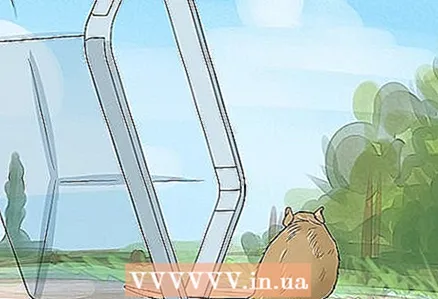 3 Release the mouse. Place the container on the ground near some bushes, logs, tall grass, or other cover so that the mouse does not have to search for a secluded spot for a long time. Remove the towel, gently turn the box onto its side, and step back a few steps. When the mouse feels safe, it will leave the container and go in search of shelter.
3 Release the mouse. Place the container on the ground near some bushes, logs, tall grass, or other cover so that the mouse does not have to search for a secluded spot for a long time. Remove the towel, gently turn the box onto its side, and step back a few steps. When the mouse feels safe, it will leave the container and go in search of shelter.  4 Disinfect used accessories. Throw away the towels and rags you used to dry the mouse, or wash them separately with gloves in the washing machine. Start a hot water cycle and add bleach to disinfect. Spray the container with disinfectant spray or simply throw it away.
4 Disinfect used accessories. Throw away the towels and rags you used to dry the mouse, or wash them separately with gloves in the washing machine. Start a hot water cycle and add bleach to disinfect. Spray the container with disinfectant spray or simply throw it away.  5 Wash your hands. Turn on the tap and rinse your hands under running water. Lather your hands for at least 20 seconds. Remember to wash under your nails, the back of your hands and between your fingers. Rinse off the soap with water. Dry your hands with a clean towel.
5 Wash your hands. Turn on the tap and rinse your hands under running water. Lather your hands for at least 20 seconds. Remember to wash under your nails, the back of your hands and between your fingers. Rinse off the soap with water. Dry your hands with a clean towel.
Part 3 of 3: How to keep mice away from home
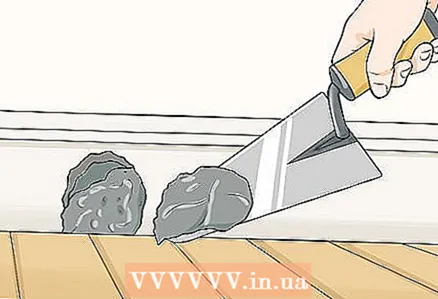 1 Seal all openings in the house. Mice can slip through holes the size of a small coin. Walk around the perimeter of the house and notice any cracks, holes, niches, openings, or other entrances. Cover them with metal or cement to keep mice and other rodents out of the house.
1 Seal all openings in the house. Mice can slip through holes the size of a small coin. Walk around the perimeter of the house and notice any cracks, holes, niches, openings, or other entrances. Cover them with metal or cement to keep mice and other rodents out of the house. - Also, don't forget to place grills on chimneys, renew the sealant on doors and windows, and seal any holes in the window frame.
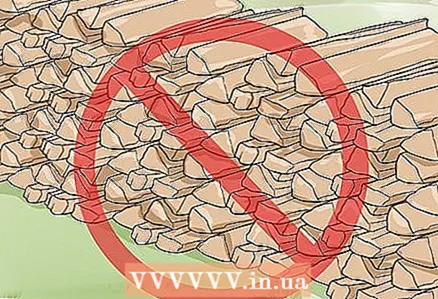 2 Eliminate all possible niches and hiding places. Mice and other rodents often hide or make holes in logs, bushes, and other places near the house. Prune bushes and grass regularly, cut off overhanging branches, and keep firewood, barbecues, patio furniture, and other items at least six meters from your home.
2 Eliminate all possible niches and hiding places. Mice and other rodents often hide or make holes in logs, bushes, and other places near the house. Prune bushes and grass regularly, cut off overhanging branches, and keep firewood, barbecues, patio furniture, and other items at least six meters from your home.  3 Remove all sources of food and water. Mice are ready to eat whatever they can find, including scraps, trash, crumbs, pet food, seeds, fruits, and more. To prevent mice from finding a food source in or around your home, you can take the following steps:
3 Remove all sources of food and water. Mice are ready to eat whatever they can find, including scraps, trash, crumbs, pet food, seeds, fruits, and more. To prevent mice from finding a food source in or around your home, you can take the following steps: - store food in sealed glass containers;
- regularly wipe floors, tables and sideboards;
- store trash and pet food in rodent-proof containers;
- clean up fallen bird food;
- pick fruits and vegetables immediately after ripening,
- eliminate water leaks, humid areas, and other sources of fresh water.
Warnings
- Do not try to pull the animal out of the trap without loosening the glue. The glue can not only pull out hair and damage the skin, but also cause serious injury.



